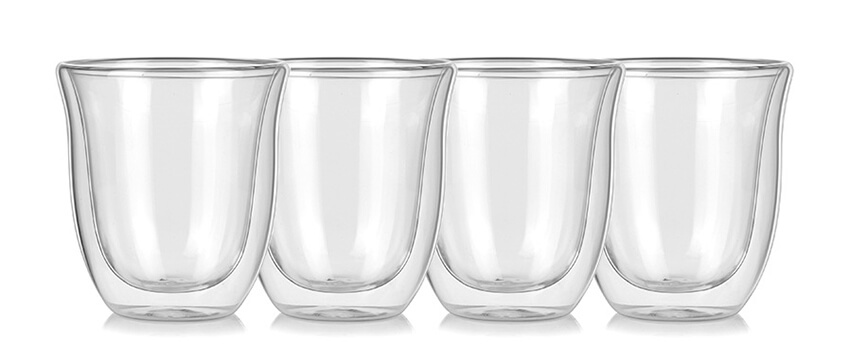In the world of kitchenware and dining, glass cups hold a place of prominence for their elegance, practicality, and versatility. However, not all glass cups are created equal. They can usually be divided into ordinary soda-lime glass, tempered glass, and high borosilicate heat-resistant glass. Distinguishing between these types can be a challenge since they often look similar. For the untrained eye, identifying high borosilicate heat-resistant glass, known for its durability and ability to withstand significant temperature changes, is no small feat. This guide aims to demystify the process, offering practical tips to ensure you can accurately judge the quality of your glassware.
Understanding the Types of Glass
Before diving into the identification process, let’s briefly outline the three main types of glass used in cup manufacturing:
- Ordinary Soda-Lime Glass: This is the most common type of glass, typically used for everyday glassware. It can withstand an instantaneous temperature difference of around 75°C, making it suitable for cold drinks and boiled water.
- Tempered Glass: Tempered glass is strengthened through a thermal tempering process, making it more resistant to physical and thermal stress than soda-lime glass. However, it’s not recommended for holding liquids due to its potential to shatter under extreme conditions.
- High Borosilicate Heat-Resistant Glass: This type of glass can endure instantaneous temperature differences of about 150°C without damage, making it ideal for both hot and cold beverages. Its manufacturing process includes manual blowing, semi-automatic assembly lines, and special pressing, contributing to its unique properties.

Understanding High Borosilicate Heat-Resistant Glass
High Borosilicate Heat-Resistant Glass is a type of glass that contains boron trioxide which allows for a very low coefficient of thermal expansion. This means it will not crack under extreme temperature changes like regular glass. Its durability and thermal resistance make it particularly suited for applications that involve rapid temperature changes or where high heat resistance is required, such as in laboratory glassware, cookware, and even in some consumer glass products like teapots and coffee cups.
Key Properties and Benefits of High Borosilicate Heat-Resistant Glass
- Thermal Shock Resistance: Due to its low thermal expansion coefficient, high borosilicate glass can endure rapid temperature changes. This makes it ideal for use in applications where the glass will be subjected to sudden shifts in temperature, such as moving from the fridge to a hot oven.
- Chemical Stability: High borosilicate glass is highly resistant to chemicals, including strong acids and bases, which makes it suitable for storing various liquids without fear of degradation or contamination.
- Durability: This type of glass is more durable and stronger than regular glass, making it less prone to cracking or breaking. This extends the life of products made from high borosilicate glass.
- Safety: In the event of breakage, high borosilicate glass tends to crack rather than shatter into jagged shards, reducing the risk of injury.
- Clarity and Aesthetics: High borosilicate glass maintains clarity over time, resisting staining and scratching. Its smooth surface and transparency make it aesthetically pleasing for kitchenware and drinkware.
- Environmental Impact: High borosilicate glass is non-toxic and lead-free, making it safer for food and drink usage. It is also recyclable, contributing to environmental sustainability.
- Temperature Resistance: It can withstand a wide temperature range, making it suitable for hot and cold beverages without risk of damage.
Identifying High Borosilicate Heat-Resistant Glass
1. Manufacturing Clues
- Thickness and Weight: High borosilicate glassware is characteristically light and thin. A glass cup with a handle that has a thickness within 2mm is likely made from high borosilicate glass. If the cup is unusually thick or heavy, it’s worth inspecting for mold marks, particularly on the handle. The absence of mold marks (with rare exceptions) indicates heat-resistant glass.
- Manufacturing Process: The double-layered glass is exclusively made from high borosilicate glass due to its need for thermal resistance. Products made from this material are generally very thin, with the thickness of tea sets and coffee sets around 1.2-1.8 mm, and pots around 1.8-2.2 mm.
2. Rapid Identification Methods
- Cold and Hot Test: Place the cup in a refrigerator for 24 hours and then pour in boiling water. If it withstands this without breaking, it’s likely high borosilicate glass.
- Transparency and Feel: Cups made from high borosilicate glass typically exhibit superior transparency, a more delicate body, and a smoother feel compared to other types.
Practical Tips for Buyers
- Ask for Details: When purchasing glassware, inquire about the manufacturing process and materials used. Reputable sellers should provide this information, helping you make an informed decision.
- Look for Labels: Some manufacturers label their products as made from high borosilicate glass. While labels can be misleading, they are a good starting point for further investigation.
- Consider the Use: High borosilicate glass is particularly suited for brewing tea or coffee, as well as serving cold drinks. Consider your intended use when choosing your glassware.

Conclusion
Identifying high borosilicate heat-resistant glass requires a keen eye for detail and an understanding of the material’s unique characteristics. By employing the methods outlined above, consumers can make more informed decisions, ensuring the glassware they purchase meets their needs in terms of aesthetics, thermal resistance, and safety. Remember, the key to distinguishing high-quality glass lies in its manufacturing clues and your ability to perform simple tests that reveal its resistance to temperature changes.
Remember
When it comes to glassware, not all glasses are created equal. The distinction between ordinary glass and high borosilicate heat-resistant glass not only affects how you enjoy your beverages but also how safely and efficiently you can use your glassware in various temperature conditions. Armed with this knowledge, you’re now better equipped to choose the right glass cups for your home or professional needs, ensuring durability, safety, and enjoyment for years to come.



2 Responses
Актуально. Скажите мне, пожалуйста – где я могу найти больше информации по этому вопросу?
Here indeed buffoonery, what that